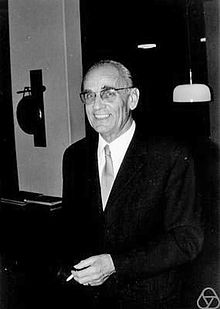Wolfgang Haack
Wolfgang Haack (born April 24, 1902 in Gotha , † November 28, 1994 in Berlin ; full name Wolfgang Siegfried Haack ) was a German mechanical engineer and mathematician .
Life
Wolfgang Haack studied mechanical engineering in Hanover and mathematics in Jena . There he received his doctorate in 1926 at the Friedrich Schiller University under Robert Haußner on the subject of "The determination of areas whose geodetic lines merge into conic sections through the mapping into the plane". After a short research stay in Hamburg and an employment as an assistant at the TH Stuttgart , he qualified as a professor at the TH Danzig in 1929 with his thesis on the "Affine differential geometry of radiation systems". After moving briefly to TH Berlin in 1935 , he accepted the call to TH Karlsruhe in 1937 . During the Second World War he was responsible for projectile design in the armaments industry . That is why he could not or did not want to answer the call to the TH Berlin in 1944. Finally, in 1949, he took over the chair for mathematics and mechanics at the TU Berlin as the successor to Georg Hamel . As a result of his efforts, but also as a recognition of his achievements, the new chair for numerical mathematics was established for him in 1964 . He held this position until his retirement in 1968.
Wolfgang Haack was made an honorary member of the Society for Applied Mathematics and Mechanics in 1992. In 1963 he was President of the German Mathematicians Association .
Act
Interface between mechanics and mathematics
Wolfgang Haack's work starts at the interface between mathematics and mechanics. His research area ranges from mechanics and differential geometry to partial differential equations and numerical mathematics. He dealt in particular with both elliptical and hyperbolic partial differential equations of the first order. Coming from differential geometry, Pfaff's differential forms were always of particular concern to him. A trained engineer , he always kept an eye on the application of mathematics , such as gas dynamics in supersonic flows . During his time in Berlin, he supervised a good dozen dissertations. Many of his students continued on the path he had mapped out in scientific research by embarking on a scientific career themselves.
During the Second World War, the patriotically minded Haack put his skills into the service of military research. He found an analytical formula for the body with the least supersonic - air resistance . This Haacksche Ogive , which represents the optimal shape of a supersonic missile, was published in 1941 by the Lilienthal Society. The Haacksche Ogive has considerably better aerodynamic properties than the Tangentialogive or even the Secantogive , which are named after their geometrical construction rules . However, the war industry did not succeed in implementing Haack's development in the manufacture of projectiles for sniper rifles in good time before the end of the war.
Pioneer of numerical mathematics
The visionary Haack recognized the potential of the computer for scientific and industrial research early on . As early as 1950 he founded a working group for electronic calculating machines with the aim of acquiring an electronic computer for the university in Berlin after Darmstadt, Göttingen and Munich. To do this, he contacted Konrad Zuse . Since the German Research Foundation did not want to provide financing because of the future importance of calculating machines, which was not foreseeable at the time, Wolfgang Haack initially acted as personally liable guarantor for the purchase price of 200,000 DM. In 1958 he succeeded in setting up the first computer at the TU Berlin. The expensive and risky acquisition was finally financed by donations, but above all by renting out computing time.
Honors
- 1983: Cross of Merit 1st Class of the Federal Republic of Germany
Works
- Wolfgang Haack: Elementary differential geometry . Birkhäuser, Basel, Stuttgart 1955.
Web links
- Literature by and about Wolfgang Haack in the catalog of the German National Library
- Biography in the commemorative publication 125 years of the Technical University of Berlin
| personal data | |
|---|---|
| SURNAME | Haack, Wolfgang |
| ALTERNATIVE NAMES | Haack, Wolfgang Siegfried |
| BRIEF DESCRIPTION | German mathematician |
| DATE OF BIRTH | April 24, 1902 |
| PLACE OF BIRTH | Gotha |
| DATE OF DEATH | November 28, 1994 |
| Place of death | Berlin |
